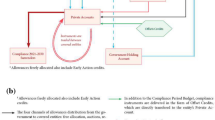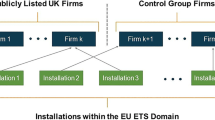Abstract
We use historical industrial emissions data to assess the level of abatement and over-allocation that took place across European countries during the pilot phase (2005–2007) of the European Union Emission Trading Scheme. Using a dynamic panel data model, we estimate the counter factual (business-as-usual) emissions scenario for EU member states. Comparing this baseline to allocated and verified emissions, we find that both over-allocation and abatement occurred, along with under-allocation and emissions inflation. Over the three trading years of the pilot phase we find over-allocation of approximately 280 million EUAs and total abatement of 247 Mt CO2. However, we calculate that emissions inflation of approximately 73 Mt CO2 also occurred, possibly due to uncertainty about future policy design features.
Similar content being viewed by others
References
Ahman M, Burtraw D, Krueger J, Zetterberg L (2007) A ten-year rule to guide the allocation of EU emission allowances. Energy Policy 35(3): 1718–1730
Alberola E, Chevallier J, Chèze B (2008) Price drivers and structural breaks in European carbon prices 2005–2007. Energy Policy 36(2): 787–797
Anderson TW, Hsiao C (1982) Formulation and estimation of dynamic models using panel data. J Econ 18(1): 47–82
Anger N, Oberndorfer U (2008) Firm performance and employment in the EU emissions trading scheme: an empirical assessment for Germany. Energy Policy 36(1): 12–22
Arellano M, Bond S (1991) Some tests of specification for panel data: Monte Carlo evidence and an application to employment equations. Rev Econ Stud 58(2): 277–297
Blundell R, Bond S (1998) Initial conditions and moment restrictions in dynamic panel data models. J Econ 87(1): 115–143
Bruno GSF (2005a) Approximating the bias of the LSDV estimator for dynamic unbalanced panel data models. Econ Lett 87(3): 361–366
Bruno GSF (2005b) Estimation and inference in dynamic unbalanced panel-data models with a small number of individuals. Stata J 5(4): 473–500
Bun MJG, Kiviet JF (2003) On the diminishing returns of higher-order terms in asymptotic expansions of bias. Econ Lett 79(2): 145–152
Considine TJ (2000) The impacts of weather variations on energy demand and carbon emissions. Resour Energy Econ 22(4): 295–314
DEHSt (2005) Implementation of emissions trading in the EU: national allocation plans of all EU states. Discussion paper, German Emissions Trading Authority
Delarue E, D’haeseleer WD (2007) Price determination of ETS allowances through the switching level of coal and gas in the power sector. Int J Energy Res 31(11): 1001–1015
Delarue E, Ellerman A, D’haeseleer WD (2008a) Short term CO2 Abatement for the European Power Sector. Discussion paper, Katholieke Universiteit Leuven
Delarue E, Voorspools K, D’haeseleer WD (2008b) Fuel switching in the electricity sector under the EU ETS: review and prospective. J Energy Eng 134(2): 40–46
Demailly D, Quirion P (2006) CO2 abatement, competitiveness and leakage in the European cement industry under the EU ETS: grandfathering versus output-based allocation. Clim Policy 6: 93–113
Demailly D, Quirion P (2008) European emission trading scheme and competitiveness: a case study on the iron and steel industry. Energy Econ 30(4): 2009–2027
Ellerman AD, Buchner BK (2007) The European Union emissions trading scheme: origins, allocation, and early results. Rev Environ Econ Policy 1(1): 66–87
Ellerman AD, Buchner BK (2008) Over-allocation or abatement? A preliminary analysis of the EU ETS based on the 2005-06 emissions data. Environ Resour Econ 41(2): 267–287
European Commission (2003) Directive 2003/87/EC of the European Parliament and of the Council of 13 October 2003 Establishing a scheme for greenhouse gas emission allowance trading within the community and Amending Council Directive 96/61/EC
Grubb M, Azar C, Persson MU (2005) Allowance allocation in the European emissions trading system: a commentary. Clim Policy 5: 127–136
Grubb M, Neuhoff K (2006) Allocation and competitiveness in the EU emissions trading scheme: policy overview. Clim Policy 6: 7–30
Houthakker HS, Verleger PK Jr, Sheehan DP (1974) Dynamic demand analyses for gasoline and residential electricity. Am J Agric Econ 56(2): 412–418
Judson RA, Owen AL (1999) Estimating dynamic panel data models: a guide for macroeconomists. Econ Lett 65(1): 9–15
Jung C, Krutilla K, Boyd R (1996) Incentives for advanced pollution abatement technology at the industry level: an evaluation of policy alternatives. J Environ Econ Manag 30(1): 95–111
Kamerschen DR, Porter DV (2004) The demand for residential, industrial and total electricity, 1973–1998. Energy Econ 26(1): 87–100
Kettner C, Köppl A, Schleicher S, Thenius G (2008) Stringency and distribution in the EU emissions trading scheme: first evidence. Clim Policy 8: 41–61
Mansanet-Bataller M, Pardo A, Valor E (2007) CO2 prices, energy and weather. Energy J 28(3): 73–92
Milliman SR, Prince R (1989) Firm incentives to promote technological change in pollution control. J Environ Econ Manag 17(3): 247–265
Montgomery W (1972) Markets in licenses and efficient pollution control programs. J Econ Theory 5: 395–418
Neuhoff K, Martinez KK, Sato M (2006) Allocation, incentives and distortions: the impact of EU ETS emissions allowance allocations to the electricity sector. Clim Policy 6: 73–91
Oberndorfer U, Rennings K (2007) Costs and competitiveness effects of the European Union emissions trading scheme. Eur Environ 17(1): 1–17
Pardo A, Meneu V, Valor E (2002) Temperature and seasonality influences on Spanish electricity load. Energy Econ 24: 55–70
Polemis ML (2007) Modeling industrial energy demand in Greece using cointegration techniques. Energy Policy 35(8): 4039–4050
Ponssard J-P, Walker N (2008) EU emissions trading and the cement sector: a spatial competition analysis. Clim Policy 8: 467–493
Reinaud J (2004) Industrial competitivieness under the european union emissions trading scheme. Discussion paper, International Energy Agency
Requate T, Unold W (2003) Environmental policy incentives to adopt advanced abatement technology: will the true ranking please stand up?. Eur Econ Rev 47(1): 125–146
Roodman D (2006) How to do Xtabond2: an introduction to difference and system GMM in stata. Discussion paper, SSRN
Sijm J, Neuhoff K, Chen Y (2006) CO2 cost pass-through and windfall profits in the power sector. Clim Policy 6: 49–72
Smale R, Hartley M, Hepburn C, Ward J, Grubb M (2006) The impact of CO2 emissions trading on firm profits and market prices. Clim Policy 6: 31–48
Stavins RN (2008) Addressing climate change with a comprehensive US cap-and-trade system. Oxf Rev Econ Policy 24(2): 298–321
Woolridge JM (2009) Introductory econometrics: a modern approach, 4th edn. Southwestern College Publishing, Cincinatti, OH
Author information
Authors and Affiliations
Corresponding author
Rights and permissions
About this article
Cite this article
Anderson, B., Di Maria, C. Abatement and Allocation in the Pilot Phase of the EU ETS. Environ Resource Econ 48, 83–103 (2011). https://doi.org/10.1007/s10640-010-9399-9
Accepted:
Published:
Issue Date:
DOI: https://doi.org/10.1007/s10640-010-9399-9




